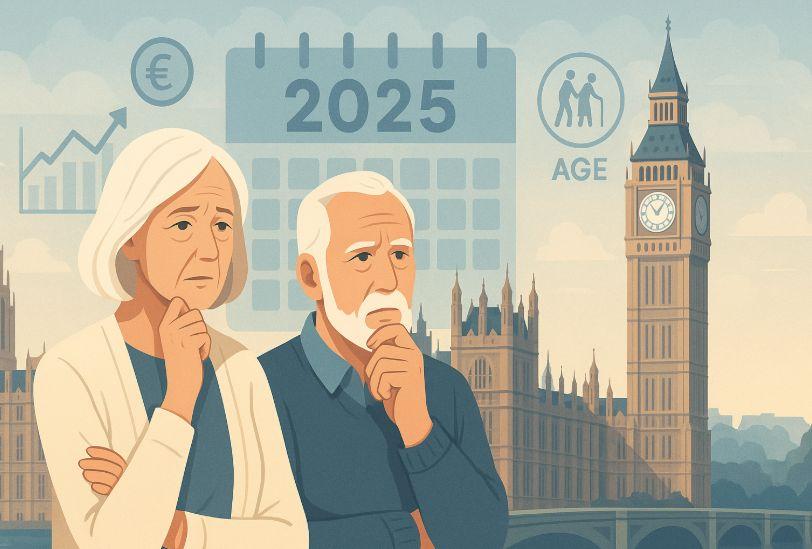The State Pension Age (SPA) affects millions of people across the UK and remains one of the most important pillars of financial planning for retirement. In July 2025, the UK government launched its third formal review of the State Pension age to determine if the existing system remains aligned with present-day demographics and economic conditions.
As the population lives longer, the sustainability of pension systems becomes increasingly important. This blog explores the core components of the 2025 review, its potential impact, and what it means for individuals preparing for retirement in the years ahead.
What is the Purpose of the 2025 State Pension Age Review?

The third State Pension Age Review, launched in July 2025, is a statutory requirement under the Pensions Act 2014. Its primary objective is to determine whether the existing timeline for increases in the pension age remains aligned with contemporary life expectancy data and economic circumstances.
Legislative Foundations
The review is mandated to occur at least once every six years to ensure that State Pension policy remains responsive and sustainable. The findings will guide decisions on the pace and timing of future increases in the pension age beyond the currently legislated schedule.
Key Review Objectives
The review is expected to examine:
- Assessing if the scheduled increase to age 67, set between 2026 and 2028, remains a suitable course of action.
- If the proposed increase to age 68, originally set for 2044–2046, should be accelerated or delayed
- The broader impact of demographic shifts, fiscal pressures, and inequalities
Who is Conducting the State Pension Age Review and Their Roles?
Two major bodies are spearheading the 2025 review, providing independent and data-driven insights.
Independent Review by Dr Suzy Morrissey
An independent assessment, led by Dr Suzy Morrissey, is examining social, economic, and demographic considerations that influence how the State Pension age should be determined.
Her work will place special emphasis on health inequalities, work patterns among older individuals, and income disparities.
Government Actuary’s Department (GAD)
The GAD is tasked with producing life expectancy projections and demographic modelling. Their analysis will explore how longer life spans impact the balance between time spent in work and in retirement, as well as the cost implications for public finances.
Department for Work and Pensions (DWP)
The DWP will consolidate the findings and formulate policy proposals for the government to consider. Their recommendations will shape the legislative and budgetary decisions regarding State Pension eligibility in the years to come.
What Are the Current and Proposed State Pension Ages in the UK?
Understanding the present and projected pension ages is essential for planning a secure retirement.
Current State Pension Age
As of 2025, both men and women become eligible for the State Pension at age 66.
Planned Changes
The current legislation outlines a phased increase:
- To age 67 between 2026 and 2028
- To age 68 between 2044 and 2046
However, the 2025 review may revise this timeline depending on its findings.
Proposed Revisions
Past discussions have suggested the possibility of bringing the age 68 threshold forward to the late 2030s. Such a move would reflect updated forecasts showing longer working lives and lower-than-expected gains in healthy life expectancy.
Why is Life Expectancy Crucial in Determining State Pension Age?

Life expectancy is one of the core metrics influencing pension policy because it affects the number of years individuals will draw pension benefits.
Trends in Longevity
Life expectancy in the UK has generally trended upward over the past several decades. However, recent data shows these gains have slowed, with regional disparities in health outcomes becoming more pronounced.
GAD Projections
The Government Actuary’s Department evaluates longevity trends to estimate how long people will live beyond retirement. These forecasts help determine if the current retirement age allows for fair and sustainable payouts without overburdening the economy.
How Does the Old-age Dependency Ratio Affect Retirement Age Decisions?
The old-age dependency ratio (OADR) compares the number of pensioners to the working-age population, and it’s a critical factor in pension policy design.
Economic Implications
A rising OADR means fewer workers are supporting a growing number of retirees, which puts pressure on public finances and pension funding. If the pension age does not rise in line with demographic shifts, the government may face increasing fiscal strain.
Demographic Balance
By gradually increasing the State Pension age, the government aims to maintain a stable ratio of workers to retirees, ensuring that pension payments remain sustainable without significant tax increases or benefit cuts.
What Role Do Employment Trends and Inequalities Play in the Review?
The ability of older individuals to remain employed varies across regions, industries, and health statuses.
Labour Market Conditions
The review will assess whether employment opportunities and workplace conditions support an older workforce. A shift in job types and a growing gig economy have changed the nature of work, and the review must consider whether these changes make it feasible for people to work longer.
Social and Health Inequalities
There are noticeable disparities in both life expectancy and overall health quality across different segments of the UK population. Individuals in physically demanding jobs or from lower-income backgrounds may find it harder to continue working into their late 60s. These disparities are central to the fairness of any proposed pension age increase.
How Could the 2025 Review Impact Future Pension Policies?

Depending on the evidence presented, the review could influence pension age changes sooner than expected.
Potential Outcomes
The government may:
- Accelerate the increase to age 68
- Adjust the method for reviewing the State Pension age
- Introduce new measures to mitigate the impact on vulnerable groups
Political and Economic Considerations
The government must balance economic realities with public sentiment. Raising the pension age is often unpopular, but may be necessary to preserve the system’s sustainability.
How Can Individuals Check Their State Pension Age and Plan Accordingly?
Planning for retirement starts with understanding when you can start receiving your State Pension and how much you are likely to receive.
Government Tools
The UK government offers an online State Pension age calculator on GOV.UK. By entering basic information such as your date of birth, you can find out your exact pension eligibility age.
Importance of National Insurance Contributions
Earning the full amount of the State Pension usually requires a minimum of 35 qualifying years of National Insurance payments.
Gaps in contribution history can reduce the amount received, making it important to check and top up if necessary.
What Can We Expect Next After the 2025 Review?
The 2025 review will culminate in a report submitted to Parliament, but the timeline for actions and policy changes may extend into the late 2020s.
Reporting Timeline
The final review is expected to be published by late 2025 or early 2026. It will outline recommendations, but implementation depends on subsequent legislation and government response.
Preparing for Change
While no immediate changes will occur in 2025, individuals approaching retirement should stay informed and adaptable. Adopting a flexible approach to retirement planning is essential for achieving long-term financial security.
State Pension Age – Current & Future Outlook
| Aspect | Current Position (2025) | Planned/Proposed Change |
| State Pension Age | 66 for men and women | Rising to 67 (2026–2028), possibly 68 sooner |
| Review Frequency | Every 6 years (as per law) | Next review beyond 2025 |
| Key Review Authorities | DWP, GAD, Independent Expert | Recommendations to Parliament |
| Influencing Factors | Life expectancy, fiscal pressure | Labour trends, health inequality |
| Eligibility Requirement | 35 years NI contributions | No proposed change |
What is the Role of Public Consultation in the State Pension Age Review UK?

Public consultation plays a vital role in shaping government policies, especially those that significantly impact citizens’ financial futures. In the context of the State Pension Age Review UK, listening to the voices of the public ensures that the changes made are equitable and reflect lived experiences across the country.
Gathering Public Opinion
While the 2025 review primarily draws on expert reports and statistical data, it also considers views from public consultations and submissions from stakeholders, including trade unions, employers, think tanks, and advocacy groups for older people. These contributions provide a broader understanding of how pension age changes might affect various demographics.
Consultations are typically conducted through:
- Public surveys on GOV.UK
- Open submissions to government committees
- Engagement with charities and regional organisations
These inputs often highlight inequalities, such as those facing people in manual labour roles who may find it more difficult to work until a later pension age.
Impact on Policy Recommendations
Although expert data is the cornerstone of the review, public responses can lead to policy adjustments or the introduction of mitigation measures, such as flexible pension access or targeted support for disadvantaged groups. This makes public engagement an essential element of democratic policymaking in the UK pension system.
How Will Changes From the 2025 Review Affect Future Generations?
While the 2025 State Pension Age Review UK focuses on near-term legislative changes, its outcomes will significantly influence the retirement prospects of today’s younger population particularly those in their 30s and 40s.
Shifting Retirement Expectations
Younger generations may face a reality where retiring at 65 is no longer viable. With pension age potentially rising to 68 or even beyond for those born after the 1980s, retirement planning will require longer working lives, greater savings discipline, and a reliance on private pensions alongside the state system.
As financial pressures on the public pension system grow, there may also be moves to encourage:
- Auto-enrolment into private pension schemes
- Later-life career retraining to keep older workers in employment
- Improved financial education around retirement planning
Intergenerational Equity
One of the central challenges in pension policy is ensuring fairness between generations. While today’s retirees may have benefited from a lower pension age and defined benefit pensions, younger workers often face higher living costs, job insecurity, and limited access to home ownership.
The 2025 review acknowledges these challenges by considering how current decisions will ripple into the future, potentially recommending staggered or conditional pension eligibility to maintain balance.
Conclusion
The 2025 State Pension Age Review is more than just a bureaucratic exercise. it represents a significant pivot in how the UK balances the promise of retirement with the realities of modern demographics and economics. While no decisions have been finalised, the trends are clear: longer working lives and evolving retirement expectations.
Resource:
- https://www.gov.uk/government/publications/state-pension-age-review-2025
- https://www.gov.uk/state-pension-age
FAQs
What is the Cridland Review and how does it relate to the 2025 pension age review?
Completed in 2017, the Cridland Review marked the second independent evaluation of the State Pension age and proposed accelerating the move to age 68.
Will the triple lock guarantee continue to apply after 2025?
As of now, the triple lock which ensures the State Pension rises by the highest of inflation, earnings growth, or 2.5% remains in place. Its continuation may be re-evaluated in future budgetary discussions.
How often is the State Pension age reviewed in the UK?
Under the Pensions Act 2014, the State Pension age must be reviewed at least once every six years.
Can early retirement affect my eligibility for the full State Pension?
Yes. Retiring early may reduce your National Insurance contributions, potentially lowering your pension amount unless you make voluntary contributions to cover the gap.
What are National Insurance contribution requirements for full pension?
You need at least 35 qualifying years of National Insurance contributions to receive the full new State Pension. Fewer years will result in a smaller payout.
How does the government decide on pension age increases?
The decision is based on several factors including life expectancy data, economic sustainability, and social equity, as evaluated in independent reviews and actuarial reports.
Where can I get advice on retirement planning in the UK?
Citizens can consult services such as MoneyHelper, Pension Wise, and financial advisers for guidance tailored to their circumstances.









Leave feedback about this